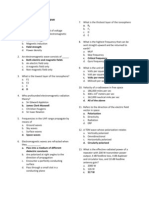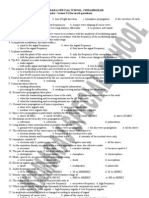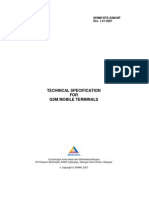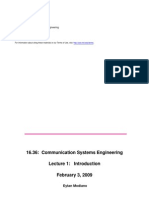01.basic Concepts
01.basic Concepts
Uploaded by
Achilles AldaveCopyright:
Available Formats
01.basic Concepts
01.basic Concepts
Uploaded by
Achilles AldaveOriginal Title
Copyright
Available Formats
Share this document
Did you find this document useful?
Is this content inappropriate?
Copyright:
Available Formats
01.basic Concepts
01.basic Concepts
Uploaded by
Achilles AldaveCopyright:
Available Formats
COMMUNICATIONS ENGINEERING PART 1
BASIC CONCEPTS
Multiple Choice: Encircle the letter that corresponds to your
answer.
1. Communication is the process of
a. keeping in touch
b. broadcasting
c. exchanging information
d. entertainment by electronics
2. Output signal of an SPST switch is an example of
a. digital signal
b. analog signal
c. discrete signal
d. electrical signal
3. Electronic communications was discovered in which
century?
a. 16
th
b. 18
th
c. 19
th
d. 20
th
4. Which of the following is not a major communications
medium?
a. free space
b. water
c. wires
d. fiber optic cable
5. Random interference to transmitted signals is called
a. adjacent channel overlap
b. garbage in garbage out
c. crosstalk
d. noise
6. The communications medium causes the signal to be
a. amplified
b. attenuated
c. modulated
d. interfered with
7. Which of the following is not a source of noise?
a. another communications signal
b. atmospheric effects
c. manufactured electrical systems
d. thermal agitation in electronic components
8. One way communications is called
a. half duplex
b. full duplex
c. monocomm
d. simplex
9. The original electrical information signal is to be transmitted
is called the
a. modulating signal
b. carrier
c. baseband signal
d. source signal
10. The process of modifying a high frequency carrier with the
information to be transmitted is called
a. multiplexing
b. telemetry
c. detection
d. modulation
11. The process of transmitting two or more information signals
simultaneously over the same channel is called
a. multiplexing
b. telemetry
c. mixing
d. modulation
12. Continuous voice and video signals are referred to as being
a. baseband
b. analog
c. digital
d. continuous waves
13. Recovering information from a carrier is known as
a. demultiplexing
b. detection
c. modulation
d. carrier recovery
14. Transmission of graphical information over the telephone
network is accomplished by
a. television
b. CATV
c. Videotext
d. Facsimile
15. Measuring physical conditions at some remote location and
transmitting this data for analysis is the process of
a. telemetry
b. instrumentation
c. modulation
d. multiplexing
16. Receiving electromagnetic emissions from stars is called
a. astrology
b. optical astronomy
c. radio astronomy
d. space surveillance
17. A personal communications hobby for individuals is
a. ham radio
b. CB radio
c. Electronic bulletin board
d. Cellular radio
18. Radar is based upon
a. microwaves
b. a water medium
c. the directional nature of radio signals
d. reflected radio signals
19. A frequency of 27 MHz has a wavelength of approximately
a. 11 m
b. 27 m
c. 30 m
d. 81 m
20. Radio signals are made up of
a. voltages and currents
b. electrons and protons
c. electric and magnetic fields
d. noise and data
21. The voice frequency range is
a. 30 to 300 Hz
b. 300 to 3000 Hz
c. 20 Hz to 20 kHz
d. 0 to 15 kHz
22. Another name for signals in the HF range is
a. microwaves
b. short waves
c. RF waves
d. Millimeter waves
23. Television broadcasting occurs in which range?
a. HF
b. VHF
c. EHF
d. ELF
24. In most microwave communication system, the connection
between the antenna and transceiver is a waveguide. What
signal that passes through the waveguide?
a. light waves
b. sound waves
c. electrical waves
d. electromagnetic waves
25. In a wireless communication system, space is used as the
medium. What carrier signal that can be used for this
purpose?
a. electromagnetic waves
b. sound waves
c. light waves
d. all of the above
26. Signal frequency that is more efficient for ground wave
propagation
a. below 2 MHz
b. between 2 MHz & 30 MHz
c. between 30 MHz & 300 MHz
d. above 300 MHz
27. In sky-wave propagation, what causes the waves to be
reflected back to ground?
a. ionosphere
b. troposphere
c. atmosphere
d. stratosphere
28. A special case of sky-wave propagation wherein the signal is
aimed towards the troposphere instead of the ionosphere.
a. troposcatter
b. forward scatter
c. tropospheric scatter
d. all of the above
29. A signal occupies the spectrum space from 1.115 to 1.122
GHz. The bandwidth is
a. 0.007 MHz
b. 7 MHz
c. 237 MHz
d. 700 MHz
30. In the United States, the electromagnetic spectrum is
regulated and managed by
a. Business and Industry
b. ITU
c. FCC
d. The United States
31. For a given bandwidth signal, more channel space is
available for signals in the range of
a. VHF
b. UHF
c. SHF
d. EHF
32. In fiber optic system, the information is carried by what
carrier?
a. light wave
b. electric wave
c. magnetic wave
d. electrical wave
33. The physical manifestation of message or idea in a
communications system.
a. signal
b. message
c. information
d. transmission
34. A portion in a communications system, which processes the
information so that it will become suitable to the
characteristic of the transmission medium.
a. encoder
b. modulator
c. transmitter
d. multiplexer
35. What do you call the medium that bridges or connects the
gap between the transmitter and receiver?
a. link
b. wire
c. space
d. channel
36. Part of a communications system that processes the output
signal from the transmission channel to the output
transducer.
a. decoder
b. detector
c. receiver
d. demodulator
37. Signal whose physical quantity varies continuously with time.
a. digital
b. analog
c. discrete
d. information
38. A signal whose value swings between two different levels
a. digital
b. analog
c. discrete
d. quantized
39. Analog information is processed with a specified degree of
a. fidelity
b. accuracy
c. sensitivity
d. selectivity
40. Digital information is processed with a specified degree of
a. fidelity
b. accuracy
c. sensitivity
d. correctness
41. Discrete signals are processed with a specified degree of
a. levels
b. accuracy
c. sensitivity
d. correctness
42. Modulation scheme wherein the analog information is riding
on another analog signal.
a. digital
b. analog
c. amplitude
d. frequency
43. In pulse modulation, what property of the signal is varied
a. phase
b. amplitude
c. frequency
d. all of the above
44. Known as digital pulse modulation.
a. PAM
b. PCM
c. PPM
d. PWM
45. In analog modulation, what properties of the carrier signal
that can be varied by the modulating signal?
a. phase
b. amplitude
c. frequency
d. all of the above
46. Modulation wherein the analog information modulates
pulses.
a. PAM
b. Pulse modulation
c. Digital modulation
d. Analog modulation
47. Signal frequency that is more effective for sky wave
propagation.
a. VF
b. HF
c. VHF
d. UHF
48. Signal frequency that is more effective for space wave
communications.
a. VF
b. VLF
c. HF
d. VHF
49. Mode of communications wherein a station can transmit to
another station while receiving from a different station.
a. Simplex
b. Duplex
c. Full Duplex
d. Full/full Duplex
50. A device that converts electrical signal to radio waves and
vice versa.
a. antenna
b. converter
c. transmitter
d. wave converter
Part 1
Basic Concepts
1. c
2. c
3. c
4. b
5. d
6. b
7. a
8. d
9. c
10. d
11. a
12. b
13. b
14. d
15. a
16. c
17. a
18. d
19. a
20. c
21. b
22. c
23. b
24. d
25. d
26. a
27. a
28. d
29. b
30. c
31. d
32. a
33. c
34. c
35. d
36. c
37. b
38. c
39. a
40. b
41. a
42. b
43. b
44. b
45. d
46. b
47. b
48. d
49. d
50. a
You might also like
- Electronics Mini Dictionary by GadgetronicxDocument49 pagesElectronics Mini Dictionary by GadgetronicxObby JhonNo ratings yet
- 1 - 300Document48 pages1 - 300Jeff Michael GomezNo ratings yet
- Basic Electronics and Communication Engineering (21ELN14/21ELN24) - Analog and Digital Communication (Module 4)Document154 pagesBasic Electronics and Communication Engineering (21ELN14/21ELN24) - Analog and Digital Communication (Module 4)Shrishail Bhat100% (1)
- 2010 Prius DTC CodesDocument112 pages2010 Prius DTC Codesgregcooler123100% (4)
- FrenzelDocument50 pagesFrenzelPaula Jane50% (4)
- Communications Engineering Part 1 Basic Concepts Multiple Choice: Encircle The Letter That Corresponds To Your AnswerDocument6 pagesCommunications Engineering Part 1 Basic Concepts Multiple Choice: Encircle The Letter That Corresponds To Your AnswerRAsuarezlimNo ratings yet
- Mock Board Examination in Esat CDocument8 pagesMock Board Examination in Esat CspidyanNo ratings yet
- Communication Source McqsDocument50 pagesCommunication Source McqsJohn Dale QuinonesNo ratings yet
- Chapter 1: Introduction To Electronic CommunicationsDocument33 pagesChapter 1: Introduction To Electronic CommunicationsMoneth PerezNo ratings yet
- Exam 1Document14 pagesExam 1RonnielynSalvadorNo ratings yet
- ESATTTDocument41 pagesESATTTyencommsNo ratings yet
- Mat Previous Year Papers SolvedDocument19 pagesMat Previous Year Papers SolvedbhavanaNo ratings yet
- Frenzel FullDocument59 pagesFrenzel FullMigz BorlonganNo ratings yet
- Electronics 100 Important MCQ PDFDocument22 pagesElectronics 100 Important MCQ PDFRaghu Veer KNo ratings yet
- Bel Test PaperDocument40 pagesBel Test PapererjayprakashpatelNo ratings yet
- (Certii) Multiple Choice Questions in CommunicationsDocument36 pages(Certii) Multiple Choice Questions in CommunicationsJunel GenorgaNo ratings yet
- WirelessDocument115 pagesWirelessMitzOsorioNo ratings yet
- ECER4 Prelim ExamDocument5 pagesECER4 Prelim ExamJonas ParreñoNo ratings yet
- Pre Board Comms 2 (Nov 2006) AnsDocument6 pagesPre Board Comms 2 (Nov 2006) AnsKurarin Jan MaikeruNo ratings yet
- MCQ's Wire and WirelessDocument28 pagesMCQ's Wire and WirelessTauqeer Maqsood0% (1)
- Wireless Comms QuizDocument4 pagesWireless Comms QuizananananymousNo ratings yet
- MCQs in Microwave Communications Part IVDocument10 pagesMCQs in Microwave Communications Part IVRaghu Veer KNo ratings yet
- 07 MicrowaveDocument6 pages07 MicrowaveAchilles AldaveNo ratings yet
- III B Tech I Semester Comprehensive Online Examination: Nov 2015Document4 pagesIII B Tech I Semester Comprehensive Online Examination: Nov 2015SukumarVictoryNo ratings yet
- Communications Past Board Exam QuestionsDocument4 pagesCommunications Past Board Exam QuestionsRowEll CañEta100% (2)
- Communications Question BankDocument15 pagesCommunications Question BankiamjaeboomNo ratings yet
- CSADDocument3 pagesCSADGhe PataniNo ratings yet
- Pre Board - ESATDocument14 pagesPre Board - ESATChristian Rey TulopNo ratings yet
- Pre Board Exam ESTDocument12 pagesPre Board Exam ESTart16marasiganNo ratings yet
- Antennas and Radio Wave PropagationDocument7 pagesAntennas and Radio Wave PropagationMike PuaNo ratings yet
- Compre Est 2016 (Done B)Document11 pagesCompre Est 2016 (Done B)Maria Anndrea MendozaNo ratings yet
- Microwave CommDocument3 pagesMicrowave CommAylie PilobelloNo ratings yet
- COMMS 3 - Microwave AnswersDocument4 pagesCOMMS 3 - Microwave AnswersRovina LacunaNo ratings yet
- 07ec502 - CT - Unit IDocument13 pages07ec502 - CT - Unit IsitvijayNo ratings yet
- Modulation: TransmitterDocument11 pagesModulation: TransmitterMarghel Rañigo BuenaventuraNo ratings yet
- ECE Board Exam April 2005 CommunicationsDocument10 pagesECE Board Exam April 2005 CommunicationsNancy Villeta RañadaNo ratings yet
- Physics One Mark OldDocument13 pagesPhysics One Mark OldGR RaghavNo ratings yet
- Communications QBDocument38 pagesCommunications QBDenaiya Watton LeehNo ratings yet
- Bai Thi Giua KiDocument5 pagesBai Thi Giua KiTàiNo ratings yet
- 01.basic Concepts1Document5 pages01.basic Concepts1dumbidumplingNo ratings yet
- Comms 8 - Wirecom & Cellular - AnswersDocument5 pagesComms 8 - Wirecom & Cellular - AnswersRovina LacunaNo ratings yet
- EST Super Compiled (IECEP)Document54 pagesEST Super Compiled (IECEP)kurte moyoNo ratings yet
- EST Super Compiled (IECEP) PDFDocument54 pagesEST Super Compiled (IECEP) PDFJohn Micoh AlvarezNo ratings yet
- C. RouterDocument10 pagesC. RouterAim HighNo ratings yet
- C. RouterDocument10 pagesC. RouterAim HighNo ratings yet
- MCQs in Microwave Communications Part IDocument10 pagesMCQs in Microwave Communications Part IRaghu Veer KNo ratings yet
- Licensure Assessment Review Evaluation 4 Answers: Rizal Technological UniversityDocument3 pagesLicensure Assessment Review Evaluation 4 Answers: Rizal Technological UniversityAaron Joseph SolanoNo ratings yet
- Comms 1 - Modulation AnswersDocument4 pagesComms 1 - Modulation AnswersRovina LacunaNo ratings yet
- MCQs in Microwave Communications Part IIIDocument10 pagesMCQs in Microwave Communications Part IIIRaghu Veer KNo ratings yet
- MCQ - SAtellite and CommunicationsDocument11 pagesMCQ - SAtellite and CommunicationsTanyaGarg100% (1)
- COMMS 2 - Antenna & RadiowaveANSWERSDocument4 pagesCOMMS 2 - Antenna & RadiowaveANSWERSRovina LacunaNo ratings yet
- Transmission Line 101Document6 pagesTransmission Line 101George Ezar N. QuiriadoNo ratings yet
- Communication QDocument4 pagesCommunication QRamchandra MurthyNo ratings yet
- Principles of CommunicationDocument2 pagesPrinciples of CommunicationGener Delovino JunioNo ratings yet
- Wire and Wireless Communications2aaaDocument11 pagesWire and Wireless Communications2aaaRonnielynSalvadorNo ratings yet
- Pre-Board Exam ElectronicsDocument3 pagesPre-Board Exam ElectronicsEugene Embalzado Jr.No ratings yet
- Refresher ModulationDocument28 pagesRefresher Modulationvon kervy onrade100% (1)
- Bai Thi Giua KiDocument5 pagesBai Thi Giua KiTàiNo ratings yet
- Radio Propagation and Adaptive Antennas for Wireless Communication Networks: Terrestrial, Atmospheric, and IonosphericFrom EverandRadio Propagation and Adaptive Antennas for Wireless Communication Networks: Terrestrial, Atmospheric, and IonosphericNo ratings yet
- Software Radio: Sampling Rate Selection, Design and SynchronizationFrom EverandSoftware Radio: Sampling Rate Selection, Design and SynchronizationNo ratings yet
- Barroso, Niko Angelo M. Broadcast Engineering: Current LoudspeakerDocument3 pagesBarroso, Niko Angelo M. Broadcast Engineering: Current LoudspeakerAchilles AldaveNo ratings yet
- How USB Ports WorkDocument5 pagesHow USB Ports WorkAchilles Aldave100% (1)
- General Packet Radio Service (GPRS)Document1 pageGeneral Packet Radio Service (GPRS)Achilles AldaveNo ratings yet
- Definitions of GPRS On The WebDocument2 pagesDefinitions of GPRS On The WebAchilles AldaveNo ratings yet
- Communication System CH#1Document28 pagesCommunication System CH#1Haylemaryam G.No ratings yet
- 7SA6xxx Catalog SIP-2008 A2 enDocument48 pages7SA6xxx Catalog SIP-2008 A2 enAndré SuzukiNo ratings yet
- (Chapter 24) Microwave Radio Communications and System Gain (178-186)Document9 pages(Chapter 24) Microwave Radio Communications and System Gain (178-186)Kim OliverNo ratings yet
- Communication Systems: 6th Semester by Ihsan Ul Haq, Assistant ProfessorDocument34 pagesCommunication Systems: 6th Semester by Ihsan Ul Haq, Assistant ProfessorIhsan ul HaqNo ratings yet
- Technical Specification FOR GSM Mobile Terminals: SKMM Wts GSM-MT Rev. 1.01:2007Document11 pagesTechnical Specification FOR GSM Mobile Terminals: SKMM Wts GSM-MT Rev. 1.01:2007Sohel HusainNo ratings yet
- AEC 207 Week 1Document11 pagesAEC 207 Week 1Ekemini SundayNo ratings yet
- Communication Systems Engineering Proakis PDFDocument2 pagesCommunication Systems Engineering Proakis PDFKimNo ratings yet
- Dcs Course FileDocument50 pagesDcs Course FilerajeshchitikenaNo ratings yet
- Military Weapons PDFDocument6 pagesMilitary Weapons PDFSatyajeet KhatkeNo ratings yet
- Laser Communication Free SpaceDocument26 pagesLaser Communication Free SpaceKushagraKapoor100% (1)
- Sistem Komunikasi Fiber Optik PDFDocument26 pagesSistem Komunikasi Fiber Optik PDFfadilahNo ratings yet
- 16.36 Communication Systems Engineering: Mit OpencoursewareDocument24 pages16.36 Communication Systems Engineering: Mit OpencoursewarePari MalaNo ratings yet
- Advance Digital CommunicationDocument31 pagesAdvance Digital CommunicationatifNo ratings yet
- Chapter 1Document27 pagesChapter 1wendye13No ratings yet
- Topic 1 Communication SystemmDocument17 pagesTopic 1 Communication SystemmRoneline LizadaNo ratings yet
- COMMUNICATION SYSTEM - Module-IDocument84 pagesCOMMUNICATION SYSTEM - Module-ICOMPETITIVE GURU JINo ratings yet
- T-001 4th 2010 Telecom SystemsDocument36 pagesT-001 4th 2010 Telecom Systemsmechmohan26No ratings yet
- Office of The Building Official: Application No. Elp No. Building Permit NoDocument2 pagesOffice of The Building Official: Application No. Elp No. Building Permit Nojjad omisolNo ratings yet
- Fundamentals of Electronics Communications SystemsDocument32 pagesFundamentals of Electronics Communications SystemsRonilloyd SantosNo ratings yet
- Digital Com theory-Compiled-P.Nagaraju PDFDocument59 pagesDigital Com theory-Compiled-P.Nagaraju PDFprashanth_02No ratings yet
- DC Lec 1Document21 pagesDC Lec 1pakeaxqNo ratings yet
- Research Work #4 (PEC)Document25 pagesResearch Work #4 (PEC)Tin VillalbaNo ratings yet
- DCE208Document21 pagesDCE208Hafeex ShuaibuNo ratings yet
- Communication System Sanjay Sharma Free PDFDocument2 pagesCommunication System Sanjay Sharma Free PDFKevin13% (30)
- Com1 Chapter 1Document32 pagesCom1 Chapter 1balkyderNo ratings yet
- Analog & Digital Communication (EC 1842)Document25 pagesAnalog & Digital Communication (EC 1842)Mayank ChoudharyNo ratings yet
- Digital Notice Board SynopsisDocument9 pagesDigital Notice Board Synopsisneha yadavNo ratings yet





























































































